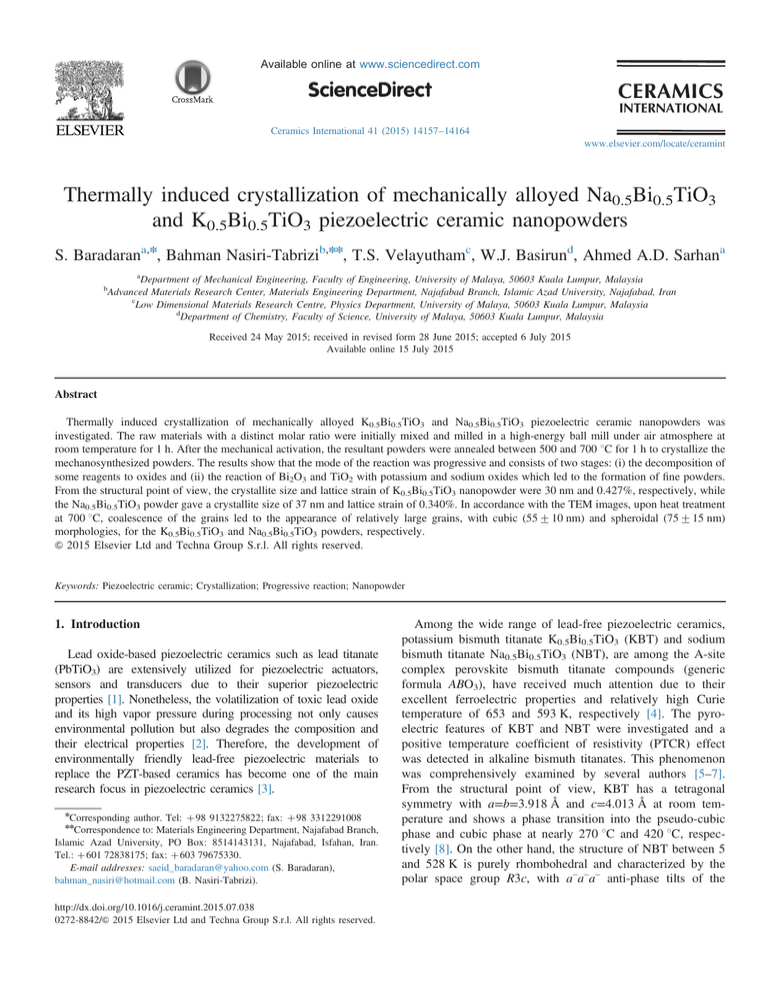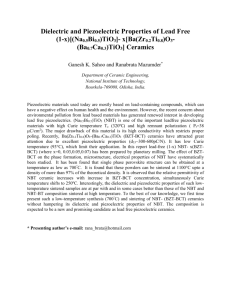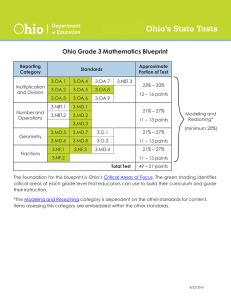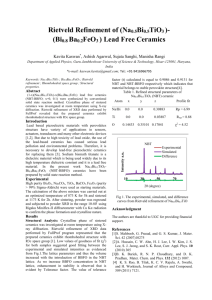
Available online at www.sciencedirect.com
CERAMICS
INTERNATIONAL
Ceramics International 41 (2015) 14157–14164
www.elsevier.com/locate/ceramint
Thermally induced crystallization of mechanically alloyed Na0.5Bi0.5TiO3
and K0.5Bi0.5TiO3 piezoelectric ceramic nanopowders
S. Baradarana,n, Bahman Nasiri-Tabrizib,nn, T.S. Velayuthamc, W.J. Basirund, Ahmed A.D. Sarhana
b
a
Department of Mechanical Engineering, Faculty of Engineering, University of Malaya, 50603 Kuala Lumpur, Malaysia
Advanced Materials Research Center, Materials Engineering Department, Najafabad Branch, Islamic Azad University, Najafabad, Iran
c
Low Dimensional Materials Research Centre, Physics Department, University of Malaya, 50603 Kuala Lumpur, Malaysia
d
Department of Chemistry, Faculty of Science, University of Malaya, 50603 Kuala Lumpur, Malaysia
Received 24 May 2015; received in revised form 28 June 2015; accepted 6 July 2015
Available online 15 July 2015
Abstract
Thermally induced crystallization of mechanically alloyed K0.5Bi0.5TiO3 and Na0.5Bi0.5TiO3 piezoelectric ceramic nanopowders was
investigated. The raw materials with a distinct molar ratio were initially mixed and milled in a high-energy ball mill under air atmosphere at
room temperature for 1 h. After the mechanical activation, the resultant powders were annealed between 500 and 700 1C for 1 h to crystallize the
mechanosynthesized powders. The results show that the mode of the reaction was progressive and consists of two stages: (i) the decomposition of
some reagents to oxides and (ii) the reaction of Bi2O3 and TiO2 with potassium and sodium oxides which led to the formation of fine powders.
From the structural point of view, the crystallite size and lattice strain of K0.5Bi0.5TiO3 nanopowder were 30 nm and 0.427%, respectively, while
the Na0.5Bi0.5TiO3 powder gave a crystallite size of 37 nm and lattice strain of 0.340%. In accordance with the TEM images, upon heat treatment
at 700 1C, coalescence of the grains led to the appearance of relatively large grains, with cubic (55 7 10 nm) and spheroidal (75 715 nm)
morphologies, for the K0.5Bi0.5TiO3 and Na0.5Bi0.5TiO3 powders, respectively.
& 2015 Elsevier Ltd and Techna Group S.r.l. All rights reserved.
Keywords: Piezoelectric ceramic; Crystallization; Progressive reaction; Nanopowder
1. Introduction
Lead oxide-based piezoelectric ceramics such as lead titanate
(PbTiO3) are extensively utilized for piezoelectric actuators,
sensors and transducers due to their superior piezoelectric
properties [1]. Nonetheless, the volatilization of toxic lead oxide
and its high vapor pressure during processing not only causes
environmental pollution but also degrades the composition and
their electrical properties [2]. Therefore, the development of
environmentally friendly lead-free piezoelectric materials to
replace the PZT-based ceramics has become one of the main
research focus in piezoelectric ceramics [3].
n
Corresponding author. Tel: þ98 9132275822; fax: þ98 3312291008
Correspondence to: Materials Engineering Department, Najafabad Branch,
Islamic Azad University, PO Box: 8514143131, Najafabad, Isfahan, Iran.
Tel.: þ 601 72838175; fax: þ603 79675330.
E-mail addresses: saeid_baradaran@yahoo.com (S. Baradaran),
bahman_nasiri@hotmail.com (B. Nasiri-Tabrizi).
nn
http://dx.doi.org/10.1016/j.ceramint.2015.07.038
0272-8842/& 2015 Elsevier Ltd and Techna Group S.r.l. All rights reserved.
Among the wide range of lead-free piezoelectric ceramics,
potassium bismuth titanate K0.5Bi0.5TiO3 (KBT) and sodium
bismuth titanate Na0.5Bi0.5TiO3 (NBT), are among the A-site
complex perovskite bismuth titanate compounds (generic
formula ABO3), have received much attention due to their
excellent ferroelectric properties and relatively high Curie
temperature of 653 and 593 K, respectively [4]. The pyroelectric features of KBT and NBT were investigated and a
positive temperature coefficient of resistivity (PTCR) effect
was detected in alkaline bismuth titanates. This phenomenon
was comprehensively examined by several authors [5–7].
From the structural point of view, KBT has a tetragonal
symmetry with a=b=3.918 Å and c=4.013 Å at room temperature and shows a phase transition into the pseudo-cubic
phase and cubic phase at nearly 270 1C and 420 1C, respectively [8]. On the other hand, the structure of NBT between 5
and 528 K is purely rhombohedral and characterized by the
polar space group R3c, with a–a–a– anti-phase tilts of the
14158
S. Baradaran et al. / Ceramics International 41 (2015) 14157–14164
2. Materials and methods
Table 1
Detailed specifications of the specimens.
Sample Powder components
S1
S2
S3
S4
S5
S6
K2CO3–Bi2O3–TiO2
K2CO3–Bi2O3–TiO2
K2CO3–Bi2O3–TiO2
Na2CO3–Bi2O3–TiO2
Na2CO3–Bi2O3–TiO2
Na2CO3–Bi2O3–TiO2
Milling time (h) Annealing temperature (1C)
1
1
1
1
1
1
–
500
700
–
500
700
2.1. Raw materials
Sodium carbonate (Na2CO3, Z 99.5%), potassium carbonate (K2CO3, 99.99%), titanium dioxide (TiO2, Z 99%), and
bismuth trioxide (Bi2O3, 99.99%) were used as reagents
without further purifications.
2.2. Mechanical activation
oxygen octahedra around the pseudo-cubic axes and parallel
cation displacements [9]. The ideal cubic perovskite structure
occurs at higher-temperatures (above 813 K). On the other
hand, the co-existence of rhombohedral and tetragonal phases
is evident between 573 and 593 K and a purely tetragonal
phase occurs at above 673 K [10]. From a synthetic perspective, piezoelectric ceramics are usually prepared by solid-state
reaction method, which consists of a calcination process below
1000 1C, where the raw materials such as Na2CO3, K2CO3,
Bi2O3 and TiO2 react with each other to form the KBT and
NBT, and a sintering process above 1000 1C [11–13]. In
accordance with previous studies, the sintering temperature of
the powders varies from 1030 to 1120 1C, which is mismatched with the report of the sample melting at 1070 1C [14].
In addition, the wet chemical synthesis techniques such as sol–
gel [3], hydrothermal [4], and molten salt methods [15] have
been developed for preparing the piezoelectric ceramics.
However, it has been reported that the hydrothermal and
sol–gel synthesis are usually long and complex processes,
involves the use of hazardous solvents such as 2methoxyethanol and expensive starting materials [15] and
often results in agglomerated particles [16]. Therefore, the
synthesis and characterization of KBT and NBT is still a
widely discussed problem. Although the optical and dielectric
properties of these ceramics, as well as structural phase
transitions have been widely studied [5,6,17], the mechanothermal synthesis and characterization of nanostructured KBT
and NBT have not been conclusively established.
From a traditional perspective of the solid-state process, the
ceramic powders are synthesized via conventional powder
processing which frequently needs high calcination temperature, long periods of milling time and repeated grindings [18].
This process can lead to an increase in the level of contamination and introduce some undesirable phases if the raw
materials are milled for extended durations [19]. It has been
shown recently that in many cases, the KBT and NBT
ceramics are not the direct products of extended milling times
(20–24 h), rather the products of high annealing temperature at
long time periods (950 1C for 10 h) [13,20,21]. Therefore, in
the present study, the influence of short-time milling (one-step
dry mechanical activation) and thermally induced crystallization on the phase transition, structural features and morphological characteristics of the KBT and NBT nanopowders were
studied with a detailed investigation on the microstructural and
chemical composition of the products.
Here, the influence of mechanical activation on mechanochemical behavior of X (Na2CO3, K2CO3)–Bi2O3–TiO2
ternary system and subsequent annealing on the crystallization
of the milled powders were studied. Therefore, the mixtures of
Na2CO3, K2CO3, Bi2O3, and TiO2 with a stoichiometric
composition were mechanically activated via high-energy ball
milling for 1 h (Table 1). It is expected that the reaction in this
system involves two steps: first, the decomposition of Na2CO3
and K2CO3 during activation and second, the reaction of Na2O
and K2O with other reagents which may lead to the formation
of the KBT and NBT nanopowders.
2.3. Preparation of nanopowders
The Na2CO3, K2CO3, Bi2O3, and TiO2 with a molar ratio of
1:1:4 (reaction 1 and 2) were initially mixed, and the powders
were ball-milled for 1 h in a high-energy ball milling using
zirconia vials (50 ml) and balls (10 mm diameter) in air
atmosphere at room temperature. The ball-to-powder (BPR)
weight ratio, total powder mass and rotational speed were 8:1,
4 g, and 500 rpm, respectively. After the mechanical activation, the powders were annealed between 500 and 700 1C for
1 h to crystallize the mechanosynthesized powder. The heating
rate from room temperature to the desired temperature was
fixed at 10 1C min–1
Na2CO3 þ Bi2O3 þ 4TiO2-4Na0.5Bi0.5TiO3 þ CO2↑
(1)
K2CO3 þ Bi2O3 þ 4TiO2-4K0.5Bi0.5TiO3 þ CO2↑
(2)
2.4. Characterization of nanopowders
The phase compositions were analyzed by powder X-ray
diffraction (XRD) analysis with a PANalytical Empyrean Xray diffractometer (Cu–Kα radiation) over a 2θ range from 201
to 801. The XRD patterns were compared to standards
compiled by the Joint Committee on Powder Diffraction and
Standards (JCPDS), with card 036-0339 for KBT and 0360340 for NBT. To identify the functional groups of the
powders, attenuated total reflection (ATR) analysis was
performed on a Tensor 27 (Bruker FT-IR spectrophotometer)
with a frequency range of 4000 400 cm 1. The microstructure of the products was analyzed with TEM (HT-7700,
Hitachi, Japan), while Energy Dispersive X-ray Spectrometry
(EDS) and elemental mapping analysis were employed to
S. Baradaran et al. / Ceramics International 41 (2015) 14157–14164
14159
Fig. 1. (a) XRD patterns of the mechanically alloyed powder and the standard samples of the raw materials as well as (b) the milled powders after thermal treatment
at 700 1C for 1 h.
investigate the chemical constituents in the selected areas and
the spatial distribution of elements in specimens.
3. Results and discussion
3.1. Phase structure and structural features (XRD analysis)
Fig. 1a shows XRD patterns of the mechanically alloyed
powders and standard samples of the raw materials. All
diffractograms display sharp diffraction peaks with cubic,
tetragonal and monoclinic symmetries, which indicates the
presence of K2O, TiO2 and Bi2O3 after 1 h of milling time.
From this profile, no trace of KBT was detected and particle
size reduction begins after the mechanical activation. The
XRD patterns of the milled powders after thermal treatment at
700 1C for 1 h are shown in Fig. 1b. The formation and
crystallization of milled powders occurred during annealing at
700 1C and the characteristic peaks of KBT with tetragonal
symmetry are as follows: (1 0 0) plane at 2θ ¼ 22.551, (1 0 1)
plane at 2θ ¼ 32.091, (1 1 1) plane at 2θ ¼ 39.461, (0 0 2) plane
at 2θ ¼ 44.591, (2 0 0) plane at 2θ ¼ 46.221, (1 0 2) plane at
2θ ¼ 52.001, (2 1 1) plane at 2θ ¼ 57.101, and (2 2 0) plane at
2θ ¼ 67.581. On the other hand, the NBT with rhombohedral
symmetry are as follows: (1 0 1) plane at 2θ ¼ 23.141, (0 1 2)
plane at 2θ ¼ 32.861, (0 2 1) plane at 2θ ¼ 40.471, (2 0 2) plane
at 2θ ¼ 46.661, (1 1 3) plane at 2θ ¼ 52.451, (1 2 2) plane at
2θ ¼ 58.191, and (2 2 0) plane at 2θ ¼ 68.481. From the XRD
profiles, it is obvious that the preferred orientation of KBT and
NBT took place along the (1 0 1) and (0 1 2) planes, respectively. In addition, it is clear that the mechanical activation was
accompanied by the simultaneous presence of uniform
(macro-) and non-uniform (micro-) strains which resulted in
both peak shift and peak broadening, respectively. After
annealing at 700 1C, the crystallization and recovery of the
crystal lattice occurred, and thus the characteristic peaks of
KBT and NBT intensified and shifted to the standard position.
Several theoretical models have been developed to obtain
structural information through mathematical analysis of the
XRD profiles [19,22]. Among them, the Williamson–Hall
equation is a simplified integral breadth method which is
based on the broadening of the diffraction lines due to the
strain and crystallite size. The equation is as follows:
B cos θ ¼
0:9λ
þ η sin θ
D
ðIÞ
where λ, D, η and θ are the wavelength of the X-ray
(0.154056 nm), crystallite size, internal micro-strain and the
Bragg angle (1), respectively. Note that B in the equation is the
peak width (in radians) after subtracting the peak width due to
the instrumental broadening. Therefore, when B cosθ is
plotted against sinθ, straight lines were obtained for samples
with slope η and the intercept 0.9 λ/D. Moreover, if we
assume that a crystallite is a sphere of diameter D surrounded
by a shell of grain boundary with thickness t, then the volume
14160
S. Baradaran et al. / Ceramics International 41 (2015) 14157–14164
Table 2
Crystallite size and lattice strain of the milled samples after annealing at 700 1C for 1 h.
Sample
Powder components
Annealing temperature (1C)
D (nm)
η (%)
f (%)
S3
S6
K2CO3–Bi2O3–TiO2
Na2CO3–Bi2O3–TiO2
700
700
30 72
37 72
0.427
0.340
9.36
7.68
fraction of the grain boundary (f) is approximately [23]
3
D
f ¼ 1
ðD þ tÞ
ðIIÞ
Here, the values of f were calculated by substituting the values
of the crystallite size obtained from the Williamson–Hall plots
with D with an assumption of t¼ 1 nm. The crystallite size, lattice
strain and volume fraction of the grain boundary of the milled
samples after thermal treatment at 700 1C are summarized in
Table 2. For the KBT powder, the crystallite size and lattice strain
are 30 nm and 0.427%, respectively, while the NBT nanopowder
exhibited a crystallite size and lattice strain of 37 nm and 0.340%,
respectively. Furthermore, from the obtained data, the volume
fraction of grain boundary of KBT and NBT powders is 9.36%
and 7.68%, respectively. This behavior suggests that the structural
features of the mechanosynthesized lead oxide-based piezoelectric
ceramics were influenced by the chemical composition of the
reagents. From a comparative view, this variation in percentage of
volume fraction of grain boundary resulted mainly from the
differences in crystallite size of the samples after annealing. This
indicates that by choosing the appropriate milling and annealing
conditions, different piezoelectric nanopowders with various
nanostructural features may be generated, where each of them
could be used for specific applications.
3.2. Evaluation of the functional groups (FT-IR analysis)
The FT-IR spectra of the milled samples before and after
thermal treatment at 700 1C were recorded in the range of
4000–400 cm–1 (Fig. 2). As can be seen, the milled powders
before thermal treatment show several bands especially above
1000 cm–1, which shows that no chemical reaction occurred during
the mechanical activation. In contrast, the annealed specimens
did not demonstrate any bands above 1000 cm–1. It should be
mentioned that, the intermediate band at approximately 2350 cm–1
is not a characteristic of the specimens; but belongs to the KBr
itself [24]. For the annealed samples, single broad bands were
observed in the range of 1000–400 cm–1, which belongs to the
stretching vibration of Ti–O [25]. From the FT-IR spectra, the
synthesized nanopowders showed high chemical purity which is
very important in piezoelectric applications.
3.3. Morphological characterization (TEM analysis)
The performances of nanostructured ceramics for piezoelectric applications are strongly dependent on their morphological
features [26]. However, particle shape analysis is one of the
most difficult problems in powder technology because there is
no general shape factor available that clearly differentiates all
possible kinds of morphologies [27,28]. Here, for a better
understanding of the effect of mechanothermal process on the
morphological features, TEM analysis was carried out at low
and high magnifications. Fig. 3 shows the morphology and
particle size distribution of the 1 h milled samples after thermal
annealing at 700 1C. At the beginning of milling, the above
mentioned system involves three types soft powders. With the
increase of the milling time (continued deformation), this soft
system may be transformed to the ductile-brittle system with
brittle components. Due to the distribution of these brittle
phases, the work hardening and transformation of ductile
particles into the lamellar shapes were the dominant phenomena.
With continued deformation, the lamellae and brittle particles
are further refined, the interlamellar spacing decreased, and the
brittle components are uniformly dispersed. Finally, a balance
between fracturing brittle particles by trapping and ductile
constituents by work hardening caused the formation of fine
powders [29].
A redistribution of defects and the formation of areas with
different concentrations of vacancy-type defects as well as the
release of internal strain may be the main reasons for the
formation of KBT and NBT nanopowders after annealing at
700 1C. From the high magnification TEM images, the
coalescence of the grains occurred upon heat treatment at
700 1C, which led to the appearance of relatively large grains
with cubic (55 7 10 nm) and spheroidal (75 7 15 nm)
morphologies, for the KBT and NBT nanopowders, respectively. In fact, during annealing at 700 1C, the fine particles
convert into individual grains, therefore the grain boundary
energy is minimized by thermal grooving; i.e., grain boundary
grooving to achieve the equilibrium of cubical and spheroidal
shapes. This phenomenon is in good agreement with previous
studies [20].
In addition, severe agglomerations occurred for both
mechanochemical reactions as observed in Fig. 4. This
behavior was due to the relatively large specific surface area
which is associated with the van der Waals interactions. From
a mechanochemical perspective, when two adjacent primary
particles collide, the coalescence may occur on the premise
that these two particles share a common crystallographic
orientation. Accordingly, two primary particles attach to each
other and combine to form a secondary particle. Since the sizes
of the secondary particles are still very small, it is reasonable
that they will continue to collide and coalesce, which may
ultimately lead to particle agglomeration [22]. Thereafter, the
substantial growth of agglomerates/nanoparticles was dominant during the annealing, therefore the KBT and NBT
nanopowders composed of both fine grains and large agglomerates at 700 1C.
S. Baradaran et al. / Ceramics International 41 (2015) 14157–14164
Fig. 2. FT-IR spectra of the milled samples before and after thermal treatment at 700 1C; (a) KBT and (b) NBT nanopowders.
Fig. 3. TEM images of (a,b) KBT and (c,d) NBT nanopowders after thermal treatment at 700 1C for 1 h at low and high magnifications.
Fig. 4. TEM images of agglomerated particles of (a) KBT and (b) NBT nanopowders after thermal treatment at 700 1C for 1 h.
14161
14162
S. Baradaran et al. / Ceramics International 41 (2015) 14157–14164
Fig. 5. EDS spectra and elemental mapping images of (a) KBT and (b) NBT nanopowders after thermal treatment at 700 1C for 1 h.
3.4. EDS analysis and elemental mapping
To achieve a better understanding of the XRD patterns, the
EDS analysis and elemental mapping are presented in Fig. 5.
From the EDS spectra, potassium, sodium, titanium, oxygen and
carbon are the major elements and contamination due to the
excessive wearing of the vial and balls was absent. This confirms
that the samples had an appropriate chemical purity owing to the
absence of chemically stable contaminants. These results are in
accordance with the XRD results, which show that the formation
of KBT and NBT nanopowders with high phase purity. On the
other hand, the similarity of the recorded data over three different
points on the samples revealed that the products had homogenous
microstructures. From the elemental mapping images in Fig. 5, an
appropriate spatial distribution of elements in the samples was
observed with the formation of homogenous microstructures after
the mechanothermal process. It is obvious that K, Na, Ti, Bi and
O as representatives of the KBT and NBT phases, had proper
distribution patterns.
3.5. Formation mechanism of KBT and NBT nanopowders
Depending on the mechanical activation conditions, the
mechanical attrition processes fall into two categories: progressive reaction and mechanically induced self-sustaining
reaction (MSR) [30]. In the first method, the reaction may
S. Baradaran et al. / Ceramics International 41 (2015) 14157–14164
extend to a very small volume during each collision, resulting
in a gradual transformation. In the second style, if the reaction
enthalpy is sufficiently high, a self-propagating combustion
reaction can be initiated after a certain time. In the selfpropagating mode, the occurrence of the combustion reaction
causes a rapid increase in temperature of the milling media,
and provides suitable conditions for a quick transformation.
This type of reaction mechanism can be predicted by calculating the adiabatic temperature (Tad). The value of Tad, the
maximum temperature which could be attained as a result of
the reaction heat, can be calculated using the following
equation [31]:
Z Tad X
Q ¼ ð ΔH 298 1Þ ¼
Cp ðProductsÞdT
ðIIIÞ
298
where Cp, ΔH 298 1 and Q are specific heat capacity, standard
enthalpy changes of formation at 298 K and heat of reaction,
respectively.
It has been reported that the reaction can be a self-sustained
combustion, when the adiabatic temperature of the reaction is
higher than 1800 K [31]. Here, due to the unavailability of
KBT and NBT thermodynamic data, the calculation of Tad is
not possible. However, owing to the lack of high exothermic
reactions, it seems that the Tad value is lower than 1800 K,
suggesting that the mode of the reaction in the above
mentioned system is a progressive reaction which involves
two stages: (i) the decomposition of Na2CO3 and K2CO3 to
Na2O and K2O, respectively, and (ii) the reaction of Bi2O3 and
TiO2 with K2O and Na2O which may lead to the formation of
KBT and NBT nanopowders, respectively. This can be
explained by the reactions shown in Eqs. (3)–(6).
14163
the combination of mechanochemical and thermal processing
methods. In this method, due to the subsequent thermal
treatment, various milled systems may be activated, which
can lead to the formation of a wide range of advanced
materials such as nanostructured compounds, nanocomposites
etc [32]. Hence, this approach is not only an interesting
method from a theoretical point of view, but also has many
attractive features for industrial applications, where simplicity
and high productivity are of prime importance.
4. Conclusion
The effect of short-time milling (one-step dry mechanical
activation) and thermally induced crystallization on the phase
transition and structural features of the KBT and NBT
nanopowders were studied by a detailed investigation of the
microstructural and chemical composition of the products.
From the XRD profiles, traces of KBT and NBT phases were
absent after the mechanical activation. During annealing at
700 1C for 1 h, crystallization of milled powders occurred and
consequently the characteristic peaks of KBT with tetragonal
and NBT with rhombohedral symmetries were identified. The
substantial growth of agglomerates/nanoparticles was dominant during the annealing, therefore the KBT and NBT
nanopowders composed of both fine grains and large agglomerates at 700 1C. From the elemental mapping images, an
appropriate spatial distribution of elements in the samples was
observed, which showed the formation of homogenous microstructures after the mechanothermal process. In a nutshell, the
above mentioned approach is not only an interesting method
from a theoretical point of view, but also has many attractive
features for industrial applications.
Na2CO3-Na2O þ CO2
(3)
K2CO3-K2O þ CO2
(4)
Acknowledgment
Na2O þ Bi2O3 þ 4TiO2-4Na0.5Bi0.5TiO3
(5)
K2O þ Bi2O3 þ 4TiO2-4K0.5Bi0.5TiO3
(6)
This work has been supported by the University of Malaya,
Grant No. UM.C/625/1/HIR/166 and FP033 2013A. The
authors are also grateful to Research Affairs of Islamic Azad
University, Najafabad Branch for supporting of this research.
This assessment was achieved from the following assumptions: (a) milling vial was sealed and isolated (b) all the
reactions occurred in the standard conditions (ΔG=ΔG1)
(c) the activity coefficient of raw materials was equal to 1,
and (d) the reactions occurred in the same physical conditions.
In the progressive reaction systems, heavy deformation is
introduced into the particles as a result of the presence of a
variety of crystal defects like dislocations, vacancies, stacking
faults, and increased number of grain boundaries. The high
defect densities induced by ball milling and the refined
microstructural features accelerates the diffusion process and
decreases the diffusion distance, respectively. Besides, the
slight increase in temperature during processing is a contributing factor for the acceleration of the diffusion process [30].
However, the KBT and NBT ceramics are not directly
produced by ball milling, but only after a proper thermal
treatment due to the redistribution of defects and the liberation
of internal strain during the annealing. This shows that the
mechanothermal method is a complex process which involves
References
[1] M. Zannen, M. Dietze, H. Khemakhem, A. Kabadou, M. Es-Souni, The
erbium's amphoteric behavior effects on sodium bismuth titanate properties, Ceram. Int. 40 (2014) 13461–13469.
[2] Y. Lia, W. Chen, Q. Xu, J. Zhou, X. Gu, Piezoelectric and ferroelectric
properties of Na0.5Bi0.5TiO3–K0.5Bi0.5TiO3–BaTiO3 piezoelectric ceramics, Mater. Lett. 59 (2005) 1361–1364.
[3] L. Hou, Y.D. Hou, X.M. Song, M.K. Zhu, H. Wang, H. Yan, Sol–gelhydrothermal synthesis and sintering of K0.5Bi0.5TiO3 nanowires, Mater.
Res. Bull. 41 (2006) 1330–1336.
[4] M.M. Lencka, M. Oledzka, R.E. Riman, Hydrothermal synthesis of
sodium and potassium bismuth titanates, Chem. Mater. 12 (2000) 1323–
1330.
[5] F. Bo, C. Zhixiong, B. Tiecheng, L. Meidong, PTCR effect in ferroelectric semiconducting ceramics with bismuth perovskite structure,
Ferroelectrics 101 (1990) 219–222.
[6] S.B. Vakhrushev, V.A. Isupov, B.E. Kvyatkovsky, N.M. Okuneva,
I.P. Pronin, G.A. Smolensky, P.P. Syrnikov, Phase transitions and soft
modes in sodium bismuth titanate, Ferroelectrics 63 (1985) 153–160.
14164
S. Baradaran et al. / Ceramics International 41 (2015) 14157–14164
[7] Q. Yuan, Y. Pu, J. Wei, Effect of reoxidation on positive temperature
coefficient of resistance behavior for BaTiO3–K0.5Bi0.5TiO3 ceramics, J.
Electroceram. 30 (2013) 98–101.
[8] X. Jing, B. Huang, X. Zhang, X. Qin, J. Wei, X. Wang, S. Yao, Z. Xu,
Z. Wang, P. Wang, Structural and electrical properties of K0.5Bi0.5TiO3
thin films for ferroelectric field effect transistor applications, J. Phys. D
Appl. Phys. 42 (2009) 045421.
[9] A.M. Glazer, Simple ways of determining perovskite structures, Acta
Crystallogr. Sec. A 31 (1975) 756–762.
[10] G.O. Jones, P.A. Thomas, The tetragonal phase of Na0.5Bi0.5TiO3—a
new variant of the perovskite structure, Acta Crystallogr. Sect. B 56
(2000) 426–430.
[11] S. Zhao, G. Li, A. Ding, T. Wang, Q. Yin, Ferroelectric and piezoelectric
properties of (Na, K)0.5Bi0.5TiO3 lead free ceramics, J. Phys. D Appl.
Phys. 39 (2006) 2277–2281.
[12] J. König, M. Spreitzer, B. Jancar, D. Suvorov, Z. Samardzija, A. Popovic,
The thermal decomposition of K0.5Bi0.5TiO3 ceramics, J. Eur. Ceram.
Soc. 29 (2009) 1695–1701.
[13] M. Davies, E. Aksel, J.L. Jones, Enhanced high-temperature piezoelectric
coefficients and thermal stability of Fe- and Mn-substituted Na0.5Bi0.5TiO3 ceramics, J. Am. Ceram. Soc. 94 (2011) 1314–1316.
[14] Y. Himura, R. Aojagi, H. Nagata, T. Takenaka, Ferroelectric and
piezoelectric properties of (Bi1/2K1/2)TiO3 ceramics, Jpn. J. Appl. Phys.
44 (2005) 5040–5044.
[15] L. Li, J. Deng, J. Chen, R. Yu, L. Qiao, X. Xing, Piezoelectric and
ferroelectric properties of 0.96(Na,K)(Nb0.9Ta0.1)O3–0.04LiSbO3 ceramics synthesized by molten salt method, J. Alloy. Compd. 471 (2009)
428–431.
[16] F. Bortolani, R.A. Dorey, Molten salt synthesis of PZT powder for direct
write inks, J. Eur. Ceram. Soc. 30 (2010) 2073–2079.
[17] J. Suchanicz, J. Kwapulinski, X-ray diffraction study of the phase
transitions in Na0.5Bi0.5TiO3, Ferroelectrics 165 (1995) 249–253.
[18] T. Lu, J. Dai, J. Tian, W. Song, X. Liu, L. Lai, H. Chu, X. Huang, X. Liu,
Synthesis of Na0.5Bi0.5TiO3 powders through hydrothermal method, J.
Alloy. Compd. 490 (2010) 232–235.
[19] C. Suryanarayana, Mechanical alloying and milling, Prog. Mater. Sci. 46
(2001) 1–184.
[20] D. Maurya, V. Petkov, A. Kumar, S. Priya, Nanostructured lead-free
ferroelectric Na0.5Bi0.5TiO3–BaTiO3 whiskers: synthesis mechanism and
structure, Dalton Trans. 41 (2012) 5643–5652.
[21] S. Zhang, T.R. Shrout, H. Nagata, Y. Hiruma, T. Takenaka, S. Member,
Piezoelectric properties in (K0.5Bi0.5)TiO3–(Na0.5Bi0.5)TiO3–BaTiO3,
IEEE Trans. Ultrason. Ferroelectr. Freq. Control 54 (2007) 910–917.
[22] P. Balaz, Mechanochemistry in Nanoscience and Minerals Engineering,
1st ed., Springer, Berlin Heidelberg, 2008.
[23] F. Sun, F.H.S. Froes, Synthesis and characterization of mechanicalalloyed TixMg alloys, J. Alloy. Compd. 340 (2002) 220–225.
[24] B. Nasiri-Tabrizi, A. Fahami, Synthesis and characterization of fluorapatite–zirconia composite nanopowders, Ceram. Int. 39 (2013)
4329–4337.
[25] R. Velchuri, B. Vijaya Kumar, V. Rama Devi, G. Prasad, M. Vithal,
Solid state metathesis synthesis of BaTiO3, PbTiO3, K0.5Bi0.5TiO3, and
Na0.5Bi0.5TiO3, Ceram. Int. 36 (2010) 1485–1489.
[26] V. Cauda, G. Canavese, S. Stassi, Nanostructured piezoelectric polymers,
J. Appl. Polym. Sci. 132 (2015) 41667.
[27] P. Pourghahrsamani, E. Forssberg, Review of applied particle shape
descriptors and produced particle shapes in grinding environments: part 1:
particle shape descriptions, Miner. Process. Extr. Metall. Rev. 26 (2005)
145–166.
[28] B. Nasiri-Tabrizi, A. Fahami, Synthesis and characterization of fluorapatite–zirconia composite nanopowders, Ceram. Int. 39 (2013)
4329–4337.
[29] A. Fahami, B. Nasiri-Tabrizi, G.W. Beall, B. Pingguan-Murphy, Effect of
ion concentration on mechanosynthesis of carbonated chlorapatite nanopowders, Mater. Lett. 146 (2015) 16–19.
[30] C. Suryanarayana, N. Al-Aqeeli, Mechanically alloyed nanocomposites,
Prog. Mater. Sci. 58 (2013) 383–502.
[31] L. Takacs, Self-sustaining reactions induced by ball milling, Prog. Mater.
Sci. 47 (2002) 355–414.
[32] M. Jalaly, M.S. Bafghi, M. Tamizifar, F.J. Gotor, Mechanosynthesis of
nanocrystalline ZrB2-based powders by mechanically induced selfsustaining reaction method, Adv. Appl. Ceram. 112 (2013) 383–388.







